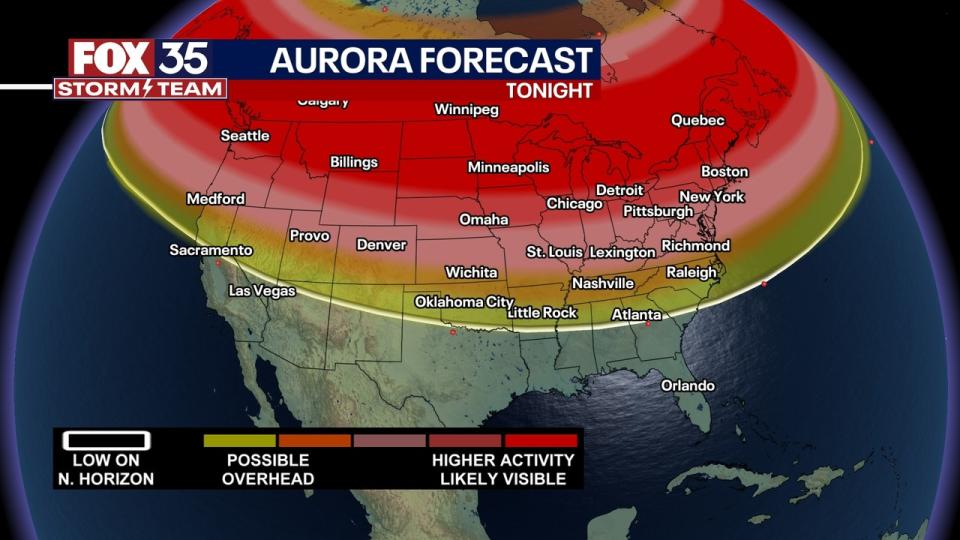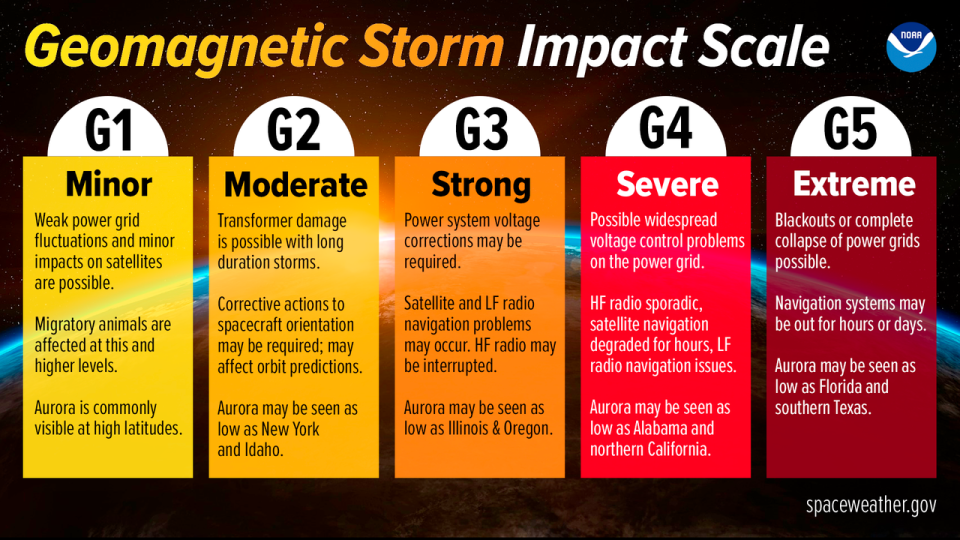Northern Lights: Could Florida see another spectacular show on Sunday?
ORLANDO, Fla. - The U.S. National Oceanic and Atmospheric Administration Space Weather Prediction Center reported Saturday afternoon that another series of coronal mass ejections (CMEs) was expected to arrive at Earth on Saturday, producing severe-to-extreme geomagnetic storms.
Canada and most of the United States were treated to a brilliant light show on Friday night and early Saturday morning. FOX 35 Storm Team Meteorologist Ian Cassette said the lights may be visible on Saturday and again on Sunday night, which may actually provide a better opportunity.
Auroras are back tonight for the US! Florida may have another shot. https://t.co/RCh4Sg86P7
— Ian Cassette FOX 35 (@iancassette_wx) May 11, 2024
Cassette said a weaker storm is expected overall.
"Technically, they are forecasting a G5 [extreme geomagnetic storm] tonight again, but it just may not be at the same strength we saw last night," Cassette added. "We're going to have another opportunity again for a G5 watch for Sunday night."
Sunspot Region 3664 remains active and continues to produce X-class flares... pic.twitter.com/yhE4vbS7FN
— NOAA Space Weather Prediction Center (@NWSSWPC) May 11, 2024
NOAA said extreme geomagnetic storm conditions continued throughout the day Saturday, and there were preliminary reports of power grid irregularities and degradation of high-frequency communications and global positioning systems. However, the Federal Emergency Management Agency said that no FEMA region had reported any significant impact from the storms as of midday Saturday morning.
Northern Lights visibility forecast: Can I see them in the United States?

Brilliant purple, green, yellow, and pink hues of the Northern Lights were reported worldwide.
In the U.S., Friday’s solar storm pushed the lights much further south than usual. The Miami office of the National Weather Service confirmed sightings in the Fort Lauderdale and Fort Myers, Florida, areas.

Tips to see the Northern Lights
According to the SWPC, there are four factors to remember when looking to view the northern lights:
Geomagnetic activity - this determines how bright (or not) the northern lights will be, as well as how they'll look across the sky
Location: It is best to be closest to the northern or southern magnetic poles
Darkness - ensure you're away from city lights to see the night sky the best. A full moon will also diminish how bright the northern lights look in the sky.
Timing: the best auroras can be seen within an hour or two before or after midnight. The best times to see the northern lights are during the spring and fall equinoxes.

FOX 35 Storm Team Meteorologist Brooks Garner captured some incredible Northern Lights images from Seminole County on Friday. He recommends that if you have a smartphone, you should consider using night mode and adjusting your exposure time to around 10 –15 seconds to capture the aurora's dance.
Other helpful tips are offered by the blog site Hello Aurora below.
It’s fading away for the moment (palm tree is most recent pic … reddish ones are from 25min ago.) #FloridaAurora #SeminoleCounty pic.twitter.com/ALiZujDpZX
— Brooks Garner (@BrooksWeather) May 11, 2024
How to capture the Northern Lights on a smartphone
If you don't have a fancy camera, the blog Hello Aurora says you can still "record impressive videos under the right conditions" using an iPhone or Android. To do so, Hello Aurora recommends the following steps:
Step 1: Open your camera app and switch to photo mode
Hello Aurora says the aurora is more visible in your camera's photo mode than in video mode due to the longer exposure time used to capture a photo.
Step 2: Record your screen using the screen recording feature of your phone
Step 3: Edit
To get the best video possible, Hello Aurora recommends editing your recorded video by removing the initial segment where you activated the screen recording and cropping the screen as you like.
When using Photo mode, Hello Aurora says this "minimizes camera shake and makes sharper images" but does vary depending on your phone model and software version. If your phone's camera quality is not clear enough to see the Northern Lights, the blog recommends downloading an external app like NightCap, to help improve visibility.
Here's to hoping you catch the elusive Green Lady dancing across the U.S. night skies this weekend.
RELATED: How to record the Northern Lights above US skies in real-time on film
Good explanation of what you saw last night...for us this far South, we see a lot of the reddish pink because at our latitude, we see the upper altitude mostly. We in the South experienced something very unique and possibly once in a lifetime for those that were curious... pic.twitter.com/Omq52fXDZp
— Dr. Marshall Shepherd (@DrShepherd2013) May 11, 2024
On Saturday morning, SpaceX’s Starlink satellite internet service said on its website that service had been degraded, and its team was investigating. CEO Elon Musk wrote on X overnight that its satellites were "under a lot of pressure, but holding up so far." A SpaceX Starlink launch that was slated for Saturday night from Cape Canaveral had been postponed to Sunday.
Major geomagnetic solar storm happening right now. Biggest in a long time. Starlink satellites are under a lot of pressure, but holding up so far. pic.twitter.com/TrEv5Acli2
— Elon Musk (@elonmusk) May 11, 2024
What is a geomagnetic storm?
For most people, a Geomagnetic Storm Watch is not something to be concerned about. The watches help government agencies, power providers, telecommunication companies, and satellite operators prepare to protect systems impacted by space weather.
Geomagnetic storms can produce stronger aurora borealis, or Northern Lights, which normally occur at the poles. However, space weather can cause the lights to expand into the northern edge of the U.S.
Geomagnetic storms could become more frequent over the next year as the sun moves into the solar maximum phase of its 11-year cycle.
A solar cycle is a sequence the sun’s magnetic field goes through every 11 years, where the field flips.

The cause? Possibly a "large, complex sunspot cluster" some 17 times Earth's diameter or solar material eruptions. According to the Space Weather Prediction Center, as that material reaches Earth, we can see those coveted lights.
Extreme (G5) geomagnetic conditions have been observed! pic.twitter.com/qLsC8GbWus
— NOAA Space Weather Prediction Center (@NWSSWPC) May 10, 2024
The SWPC said that some communications, GPS, power grids, and satellite navigation could be interrupted due to space weather, and critical infrastructure operators have been notified.
This is considered a rare event. Only three G4 storms have occurred since 2019; the last "Extreme"—or G5—event happened in October 2003. The SWPC said that one resulted in power outages in Sweden and damaged transformers in South Africa.


